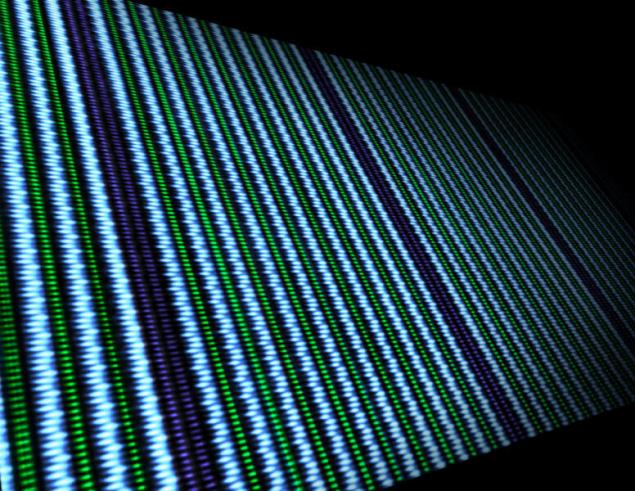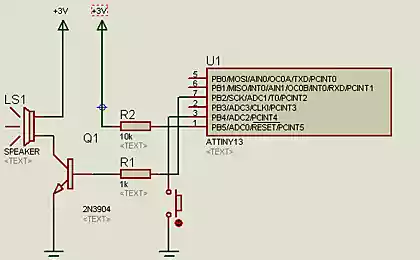451
"Atomic sandwiches," can reduce power consumption of computers 100 times
Scientists from the National laboratory behalf of the Lawrence Berkeley and Cornell University have developed a new multiferroics – a material which combines both magnetic and electrical properties. With it in the future it will be possible to create a new generation of devices with more computing power and less energy consumption.
The multiferroics are materials that exhibit at least two of the three properties: ferromagnetism (iron in the magnetization to preserve this condition), ferroelectrical (the occurrence of spontaneous dipole moment) or magnetoelastic (spontaneous deformation). The researchers in their work has spanned ferromagnetically and ferroelectric materials so that their location can be controlled using the electric field at a temperature close to the room.

The authors constructed a hexagonal atomic the film of lutetium iron oxide (LuFeO3). The material has a pronounced ferroelectric and magnetic properties. It consists of alternating monolayers of oxide and lutetium oxide of iron. To create a "nuclear sandwich", the researchers turned to the technique of molecular beam epitaxy. It is possible to assemble two different materials in one, atom by atom, layer by layer. During Assembly it was found that if you enter after every ten such alternations, one additional layer of iron oxide, it is possible to completely change properties of the material and to pronounced magnetic effect. They used 5-volt sensor of the atomic force microscope to switch the polarization of ferroelectric up and down, creating a geometric pattern of concentric squares.
Laboratory tests have shown that magnetic and electric atoms can be controlled using an electric field. The experiment was carried out at a temperature of 200-300 Kelvin (-73 – 26 degrees Celsius). All the previous work only worked at lower temperatures. Of multiferroics, created by the joint efforts of the laboratory behalf of the Lawrence Berkeley and Cornell University is the first material that can be operated at a temperature close to the room. "Together with our new material we now know of only four that exhibit multiferroic properties at room temperature. But only one of them magnetic polarization can be controlled using electric fields," says Darrell Shlomo, Professor of Cornell University, which is one of the main participants of the study. This achievement can then be used to create microprocessors with low power consumption, storage devices and new generation of electronics.

In the near future, scientists plan to investigate the possibility of reducing the voltage threshold needed to change the direction of polarization. To do this, they are going to conduct experiments with different substrates to create new materials. "We want to show that multiferroics will work on half a volt as well as five," says Ramamurthy Ramesh, Deputy Director of the national laboratory behalf of the Lawrence Berkeley. In addition, they hope to create a valid device based on the multiferroic in the near future.
For Ramesh, this is not the first achievement. In 2003, he and his team have successfully created a thin film of one of the most famous multiferroic – bismuth ferrite (BiFeO3). Dense masses of bismuth ferrite are insulating material, and the film, which can be extracted from it, can conduct electricity at room temperature. Another major achievement in the field of creation of multiferroic also applies to 2003. Then a team of Tokur Kimura discovered a new class of these materials, in which magnetism causes ferroelectric properties. These achievements were the starting point for the main ideas in this area.
The realization that these materials have great potential for practical application has led to extremely rapid development of multiferroics. They require much less energy for reading and writing data than current devices based on semiconductors.
In addition, these data do not become zero after a power failure. These properties allow to design devices which will be sufficiently short electrical pulses instead of a constant current required for modern devices. According to estimates by the makers of the new multiferroic devices using this technology will consume 100 times less power.
Today about 5% of world energy consumption is attributable to the electronics. If in the near future to achieve serious achievements in this field, which will lead to lower energy use, this figure will rise to 40-50% by 2030. According to the energy information Administration of the United States, in 2013, global consumption of electricity amounted to 157,581 TWh. In 2015 there has been stagnation in global consumption due to the reduction of growth in China and recession in the United States. published
Source: geektimes.ru/post/281776/
The multiferroics are materials that exhibit at least two of the three properties: ferromagnetism (iron in the magnetization to preserve this condition), ferroelectrical (the occurrence of spontaneous dipole moment) or magnetoelastic (spontaneous deformation). The researchers in their work has spanned ferromagnetically and ferroelectric materials so that their location can be controlled using the electric field at a temperature close to the room.

The authors constructed a hexagonal atomic the film of lutetium iron oxide (LuFeO3). The material has a pronounced ferroelectric and magnetic properties. It consists of alternating monolayers of oxide and lutetium oxide of iron. To create a "nuclear sandwich", the researchers turned to the technique of molecular beam epitaxy. It is possible to assemble two different materials in one, atom by atom, layer by layer. During Assembly it was found that if you enter after every ten such alternations, one additional layer of iron oxide, it is possible to completely change properties of the material and to pronounced magnetic effect. They used 5-volt sensor of the atomic force microscope to switch the polarization of ferroelectric up and down, creating a geometric pattern of concentric squares.
Laboratory tests have shown that magnetic and electric atoms can be controlled using an electric field. The experiment was carried out at a temperature of 200-300 Kelvin (-73 – 26 degrees Celsius). All the previous work only worked at lower temperatures. Of multiferroics, created by the joint efforts of the laboratory behalf of the Lawrence Berkeley and Cornell University is the first material that can be operated at a temperature close to the room. "Together with our new material we now know of only four that exhibit multiferroic properties at room temperature. But only one of them magnetic polarization can be controlled using electric fields," says Darrell Shlomo, Professor of Cornell University, which is one of the main participants of the study. This achievement can then be used to create microprocessors with low power consumption, storage devices and new generation of electronics.

In the near future, scientists plan to investigate the possibility of reducing the voltage threshold needed to change the direction of polarization. To do this, they are going to conduct experiments with different substrates to create new materials. "We want to show that multiferroics will work on half a volt as well as five," says Ramamurthy Ramesh, Deputy Director of the national laboratory behalf of the Lawrence Berkeley. In addition, they hope to create a valid device based on the multiferroic in the near future.
For Ramesh, this is not the first achievement. In 2003, he and his team have successfully created a thin film of one of the most famous multiferroic – bismuth ferrite (BiFeO3). Dense masses of bismuth ferrite are insulating material, and the film, which can be extracted from it, can conduct electricity at room temperature. Another major achievement in the field of creation of multiferroic also applies to 2003. Then a team of Tokur Kimura discovered a new class of these materials, in which magnetism causes ferroelectric properties. These achievements were the starting point for the main ideas in this area.
The realization that these materials have great potential for practical application has led to extremely rapid development of multiferroics. They require much less energy for reading and writing data than current devices based on semiconductors.
In addition, these data do not become zero after a power failure. These properties allow to design devices which will be sufficiently short electrical pulses instead of a constant current required for modern devices. According to estimates by the makers of the new multiferroic devices using this technology will consume 100 times less power.
Today about 5% of world energy consumption is attributable to the electronics. If in the near future to achieve serious achievements in this field, which will lead to lower energy use, this figure will rise to 40-50% by 2030. According to the energy information Administration of the United States, in 2013, global consumption of electricity amounted to 157,581 TWh. In 2015 there has been stagnation in global consumption due to the reduction of growth in China and recession in the United States. published
Source: geektimes.ru/post/281776/






















